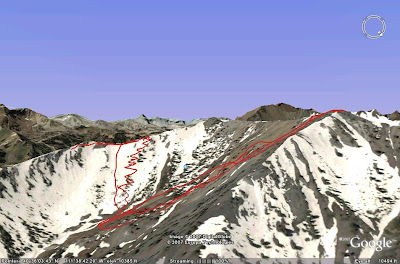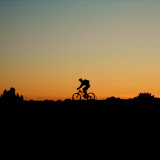Here are some things that I should have known or wished I had known when I jumped into CX racing:
Remount: Sometimes it hurts. One of the first observations/questions that newbies like me make/ask is: whoa, does the superman remount hurt? Take it from me that if someone tells you that the remount never hurts they are either: (a) a eunuch, (b) a female, or (c) lying. The idea is to land on the saddle with your inner thigh and then slide onto the saddle. But the reality is that in the heat of the moment you will likely jump too high and miss the intended target, and it will hurt. But, as the saying goes, no pain, no gain. So, my recommendation to you is to simply go for it. Sure, you might get hurt, but if you don't simply throw caution into the wind and launch like superman, you will never experience the thrill of sticking a perfect, fast remount.

Dismount: Forget the "Step Through." Fast, experienced CX'ers often talk about the "step through" dismount, a move by which the rider swings her leg over the saddle, steps through between the frame and the other leg, and then unclicks from the peddle. Confusing? That's what I thought. Add to that the furor and pandemonium of a cross race and it really gets confusing. Is it my left leg or right leg? Do I step through before or after I unclick? How do I push my leg through the small gap between my other leg and the frame when I am about to smash into the barriers? What happens if I step into my front spokes? Chances are that you will be confused on race day. That's why I suggest that you simply forget about executing the "Step Through." My advice is to simply not think about it, but to simply react. Yes, it's risky and it's a slightly Zen approach in that it is purely spontaneous, but you will be surprised at how fast your reflexes can be. I call this the "Banzai" tecnique. Most of the time, the results are surprisingly good. I'm speeding into the barrier, the leg quickly swings over, the foot unclips, the legs spring over barriers, and voila . . . success. Occasionally, I catch myself even doing the step through technique. It's all about letting the body mindlessly react. Our bodies have this built-in survival/defense mechanism, which if nurtured, will allow us to clear the barriers with ease. Maybe one of these days I may catch myself hopping the barriers ala Ali. Of course, in the interest of full disclosure, you should be aware that there will be times when the Banzai Approach turns Kamikaze and you piledrive a barrier and go down in a ball of flames, which leads me to my next point.
Crashing. I maintain that if you aren't riding on the edge of your ability, then you aren't really CX'ing and that you are depriving yourself of the fun of CX. Obviously there is a downside to this: crashing. I've tried to think of a preparation program for the inevitable crash, one that will allow me to crash, but emerge unscathed. I've taken somewhat of an old school approach to this. You know how in the old days cyclists raced into shape? Rather than doing pre-season, structured training, cyclists would go and race, and eventually, after doing many races, they would find their racing form. Applied to crashing, rather than doing exercises to prevent or mitigate crashes, I simply go race. Inevitably I crash, but after crashing several times, my "crashing form" emerges. Just like many seasoned pros report that they feel racing sensations in their legs, I often develop a sense of good crashing sensations. I can tell when I have crashing form when I am off the ground before I even realize that I was on the ground. I can tell when I have crashing form when I slide for 10 meters and emerge unscathed. I can tell when I have crashing form when someone tells me, "wow, you crashed 9 times in that race," and my response is, "really, that many? I only remember crashing once" (true story . . . almost).
The alternative to racing into "crashing form" is to simulate crashes -- like racers nowadays train under simulated race conditions. I've never attempted this, but if I were to develop such a plan, it would involve making high speed turns on an off-cambered layer of pea gravel, riding my bike straight into trees, fences, and/or small buildings, and riding through quicksand. Revel in the crashes!
Ride With Humility, but Never Give Up. Mental toughness is required in CX'ing. Likewise, humility is also required. You won't learn how to go faster if you don't keep an open mind, don't accept criticism, and are unwilling to change your ways. It's kind of a paradox: be strong and tough, but be open and willing to change.
Let me illustrate: in the recent race at Wheeler, I felt like I got a crappy start, I forgot to turn in a muddy singletrack section and went zooming into a bush, I was off the back in virtually last place, and doubt began to seep in. At one point, for some weird reason, I heard myself ask myself if I was the Rudy (not NY Rudy, but football Rudy -- the wannabe football player) of the Utah Cyclocross A Flite. I was tempted at one point to say, stuff it, I'm just not cut out for this. But I didn't. I rallied. My thought process went somehting like this:
Me: Okay, so you got a "bad" start.
Me again: But when have your really had a good start? You never get a good start so why should your "bad" start affect you now?
Me: True. I need to forget about using the bad start as an excuse and get to it. Be tougher. But it's pointless since I lost time in the bushes.
Me again: So what. Once you crashed 9 times and still had a good finish.
Me: True again. Never give up . . . never give up . . . I think I can, I think I can. But wait a minute. The simple fact is that I'm not as fast as all those guys in front of me. They have skillz. I don't.
Me again: That's not humility. That's self-pity. Get over it. This is your chance to learn to be faster. If you're not fast, or if you think you're not fast, then figure it out. Rather calling me "Rudy," focus your energy on picking the right lines and putting the power down. Dork.
Me: That's not nice.
And so the dialogue went between me and myself. . . . Eventually, I caught the group in front of me, and did not ultimately finish in last place (not that there's anything wrong with that).
Look Forward to Be Treated Like a Rockstar. One of the cool things about CX is that it is spectator and family friendly. One of the really cool things about CX is the announcers -- Gardie and Bruce. These guys are the definition of charisma. They have a knack for simultaneously calling the race and infusing the racers with energy. Part of their aura likely has to do with the fact that the populus (male and female) have determined that they are in the top 4 of Who's the Hottest Cyclist in Utah, and this list includes both males and females. To hear your name over the loudspeaker is sufficient reason to race. And if that doesn't get you there, just come to see Hot Gardie and Hot Bruce in action (not that there's anything wrong with it).
















